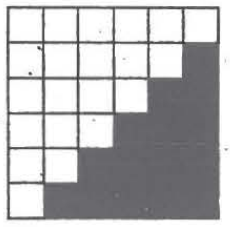(41.)
(42.) ACT The largest square in the figure below is partitioned into 36 congruent smaller
squares.
What fraction of the interior of the largest square is black?

$ F.\;\; \dfrac{5}{12} \\[5ex] G.\;\; \dfrac{1}{2} \\[5ex] H.\;\; \dfrac{7}{12} \\[5ex] J.\;\; \dfrac{5}{8} \\[5ex] K.\;\; \dfrac{5}{6} \\[5ex] $
6 by 6 = 36 congruent squares
1st row = all white
2nd row = 5 white, 1 black
3rd row = 4 white, 2 black
4th row = 3 white, 3 black
5th row = 2 white, 4 black
6th row = 1 white, 5 black
$ number\;\;of\;\;black\;\;squares = 1 + 2 + 3 + 4 + 5 = 15 \\[3ex] fraction\;\;that\;\;is\;\;black = \dfrac{15}{36} = \dfrac{5}{12} $
What fraction of the interior of the largest square is black?

$ F.\;\; \dfrac{5}{12} \\[5ex] G.\;\; \dfrac{1}{2} \\[5ex] H.\;\; \dfrac{7}{12} \\[5ex] J.\;\; \dfrac{5}{8} \\[5ex] K.\;\; \dfrac{5}{6} \\[5ex] $
6 by 6 = 36 congruent squares
1st row = all white
2nd row = 5 white, 1 black
3rd row = 4 white, 2 black
4th row = 3 white, 3 black
5th row = 2 white, 4 black
6th row = 1 white, 5 black
$ number\;\;of\;\;black\;\;squares = 1 + 2 + 3 + 4 + 5 = 15 \\[3ex] fraction\;\;that\;\;is\;\;black = \dfrac{15}{36} = \dfrac{5}{12} $